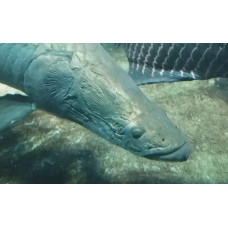Latin name
Arapaima gigas
Other name
Pirarucu, or paiche.
Identification
The body of the arapaima is elongated and compressed from the sides. It is covered with large, raised scales. The head is elongated and covered with bony plates. It is strongly flattened from above. The mouth is wide and the belly is rounded. Its meat is reddish-orange. Its tongue bears sharp, bony teeth that, together with the palatine teeth, are used to hold and pulverize prey. Males are slimmer and more colorful than females.
Features of fish fins
The dorsal and anal fins are quite long. The dorsal fin is located at the rear of the body on the caudal peduncle, directly above the anal fin. Together with the caudal fin, they form an effective "paddle," giving the fish powerful acceleration when it attacks prey. The pectoral fins are located low on the belly.
Fish colouring
The anterior part of the body is brownish-olive with a greenish-blue tint. At the level of the beginning of the unpaired fins, the color gradually changes to reddish, becoming darker red towards the tail. The tail has a wide, dark border. The gill covers are red as well.
Distribution
It is widespread in the Amazon River basin of Brazil, Guyana, and Peru.
Habitat
It dwells in densely overgrown floodplains of rivers and lakes with aquatic vegetation, in swamps, and in other floodplain bodies of water. It prefers water with a temperature of +25...+29 °C, a pH of 6.0-6.5, and a hardness of dH = 10°. It is a bottom-dwelling fish.
Size
It is one of the largest freshwater fish in the world. Its length usually reaches 2 meters, though some individuals grow to 3 meters. According to unconfirmed reports, the longest recorded length is 4.6 meters, and the maximum recorded weight is 200 kilograms.
Behavior
During the dry season, it inhabits lakes and rivers. During the rainy season, it moves to flooded floodplain forests.
Thanks to a tissue permeated with a dense network of blood vessels similar to lung tissue, it can breathe atmospheric air. This tissue covers the throat and swim bladder, which has a cellular structure and serves as an additional respiratory organ. This adaptation evolved due to the low oxygen content of Amazonian waters. Thus, the arapaima can survive droughts by swallowing air and burrowing into the mud and sand of swamps. It swims to the surface for air every 5 to 20 minutes; the sound of the arapaima swallowing air can be heard from far away.
Food and feeding habits
This predator mainly feeds on fish but occasionally eats other small animals, including birds. It hunts mainly near the surface of the water.
Reproduction
It becomes sexually mature in its fifth year of life. The length of first-time spawning fish ranges from 160 to 170 cm to 210 to 215 cm. It spawns in April and May. It breeds in shallow areas with clear water and a sandy bottom. There, it builds a nest by digging a 50-80 cm wide, 15-20 cm deep hole. The female lays large eggs in this nest. The male carefully guards the eggs and young above the clutch. The eggs hatch in 36-48 hours. During this time, the female carefully patrols the 10–15-meter zone around the nest. After hatching, the larvae stay near the male's head and feed on a white substance secreted by glands behind his eyes.
The fry grow quickly, becoming predators a week after the yolk sac is resorbed. On average, they grow 5 cm per month (from 2.5 to 7.5 cm).
Fishing
It is used for industrial fish breeding and has been introduced to bodies of water in Thailand and Malaysia.
Relationship with a person
The arapaima is often kept in large public and amateur aquariums around the world, as well as in zoos. Its white, dense, almost boneless meat is eaten.
| Classification | |
| Phylum | Chordata |
| Class | Actinopterygii |
| Squad | Osteoglossiformes |
| Family | Arapaimidae |
| Genus | Arapaima |
| Species | A. gigas |
| Features | |
| Conservation status | Data Deficient |
| Habitat | Bottom |
| Life span, years | No information |
| Maximum body weight, kg | 200 |
| Maximum length, cm | 460 |
| Sailing speed, m/s | No information |
| Threat to people | Edible |
| Way of eating | Predator |
Arapaima
Tags: arapaima


